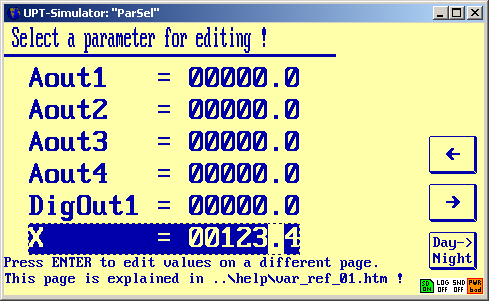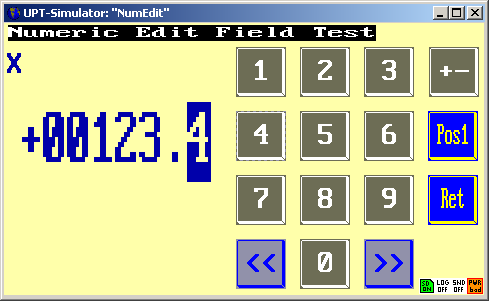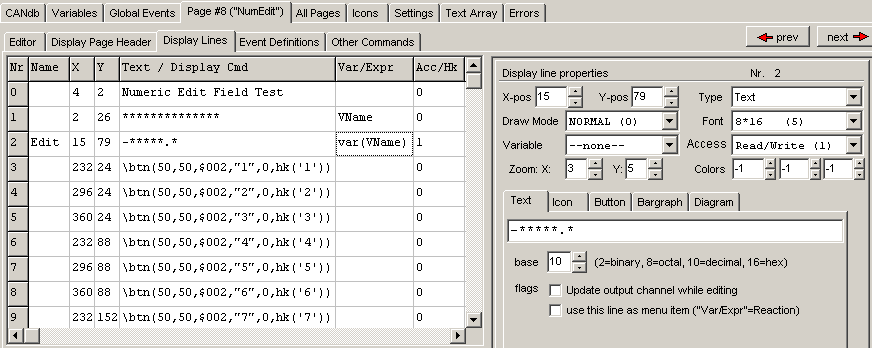![]()
![]() (only
available for terminals with 32-bit CPU, for example "MKT-View II")
(only
available for terminals with 32-bit CPU, for example "MKT-View II")
This document describes a rarely used, "special" function of some programmable CAN display terminals by MKT Systemtechnik.
The "var"-function allows to pass a reference
to a variable between display pages (see
example below), and -possibly- between
subroutines.
As a programmer, you certainly know variable references from programming languages (like "C"), where special operators are used for references. For example, in the "C" programming language, the asterisk (*) is used for the dereference operation, while the ampersand (&) is used for the reference operation .
Here, in the UPT display interpreter, no special operators are used to reference a variable, but a quite simple (?) principle explained in the next chapter.
The var command/function is used to reference a variable by its name. The keypoint is that the name itself doesn't need to be constant, but variable .
When called as a function, "var" locates the global variable with the specified name, and returns the value of that variable. The name itself can be stored in another variable (a string variable), or be the result of a function call, or any other expression which returns a string.
When called as a procedure, "var" permits a write-access to the specified variable (of course, only if that variable itself it writeable, too). The following examples will clarify the principle.
For the following example, let's assume that 'VName' is a string variable which is, for the moment, not connected to a communication channel (in other words, it's "purely internal" and exists only inside the terminal). 'X' is another variable, declared as integer or floating point.
@X = 12345 : REM set 'X' to 1234
@VName = "X" : REM set 'VName' to "X" (a STRING of characters)
var(VName)=123 : REM actually sets 'X' to 123 (write-access)
@X = var(VName)+1 : REM actually increments 'X' by one
Looks trivial... but imagine what you can do with this mechanism :
This way, you can use the same display page to edit dozen of different variables, called from different display pages, just by passing the name of the variable to the "Edit"-page instead of putting the name of the edited variable on the edit-page itself.
There is a simple example for the 'var'-function in \programs\MKTview2\MV2_Demo.CVT (these demos are located in the "programs" folder of the programming tool, not in the "Programs" folder of 'windows'). On the page named "ParSel", there is a list of parameters selectable for editing.

When selecting any of these parameters with the rotary knob, and pressing
the knob (or ENTER-button) to edit them, the program switches to another
page named "NumEdit", where the selected parameter can be edited on a special
screen with a touch-sensitive numeric
keyboard .
Important: The edited 'parameter' on that page is the expression var(VName)
but not a fixed, "hard-coded" variable.
The name of the currently edited variable is displayed (here: "X"), and -of
course- the current value using larger digits :

How does this work ?
To retrieve the name of the variable to edit, the following event definition is used (on the page "ParSel" in the demo application):

The event "mm==2" detects that an edit field on the current display page
has been switched into EDIT mode.
In the reaction method for this event, the program takes the name of
the variable connected to the current edit field, and stores it in the (string-)
variable 'VName'. Then, the display program calls the 'NumEdit' page. Let's
look a bit closer at this event definition, because it's the key point here:
@VName=disp.li[mi].vn : c"NumEdit" : REM call the
"editor"
The variable 'VName' is used to pass a reference (here: "the name of") another variable from one display page to another. Here's how we retrieve the name of the variable in the currently selected line. It's a bit tricky, but make sure you understand every bit :
mi = 6, i.e. the 6th line of the current
display page is currently selected . Remember that all elements on a display
page are internally structured like an array. The 'mi' function just returns
an index into that array. And that's what we need here: access the mi-th
array element on the current display page. It doesn't matter if the selected
element is really a "menu" item, or a text line with numeric output, a graphic
button, an icon, or whatever. All these elements are arranged in a (kind
of) array, and have a unique array index.
disp.li[mi] returns a reference to the mi-th display
line. It doesn't matter which kind of display element is defined in this
line. Here, it's just a simple text, used for a menu, but it could also be
a button, icon, or other graphic element.
vn component = "variable
name").
On the 'Editor' page, the expression var(VName) is entered in the Var/Expr
colum of the display page definition table.
There's nothing special about the keyboard on this page, except that all
numeric keys are defined as graphic buttons, which can be operated via
touchscreen (if the device has a touchscreen). The buttons send an ASCII
character into the keyboard buffer, so they behave like "real" keys on a
"real" keyboard.

To make the parameter editable, the access is set to "Read/Write" on the display page property tab. This is possible, because "var" is not just an interpreter function (which returns a value), but also an interpreter command (which, in this case, sets a new value).
< To Be Continued ... >
See also:
Last modified: 2009-01-16 by WoBu